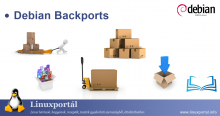Content
Overview
Debian in its stable version offers the use of stable packages by default, which can be used to build extremely reliable systems. The packages in it have been tested as extensively as possible, so there is almost no chance of anything going wrong with them. However, this has the disadvantage that in many cases the packages are not up-to-date, so it is often the case that newer versions of the same packages are available in other Linux distributions. Debian offers a solution to this backports storage.
The Debian Backports repository is the repository for packages that Debian takes over from the next release ("testing") that are aligned and recompiled for a stable release of Debian. Since the packages are also included in the next release of Debian, you can easily upgrade the stable + backports system when the next release of Debian is released. In some cases, usually for security updates, backports packages may be migrated from the "unstable" release of Debian.
Packages in the backports repository are not as extensively tested as packages in the stable release of Debian, so they may be incompatible with other components of the system and may pose a security risk to the system as a whole. Therefore, use with caution is recommended!
Therefore, Debian strongly recommends that you install only the custom packages you really need from the backports repository, but by no means update all the packages in the entire backports repository on your system!
Sloppy distributions
To ensure a clean distribution upgrade path from a previously stable distribution to the next stable, it is not permitted to upload packages from the current test version to that backport distribution. To enable some newer packages, so-called "Sloppy" distributions have been created for these systems.
These have a role when packages that come from the distribution's backports repository are also in use when updating a distribution. In this case, it is possible to update these newer packages via this when updating the distribution.
use
The backports storage is APT package manager can be configured by configuring, so the source file must be modified first.
Luggage storage setup
Examples of different Debian versions trunk to set up. To do this, open the APT package manager source file root-Kent:
nano /etc/apt/sources.listThen we will add the line corresponding to our version of Debian.
Debian 10 (Buster) configuration
deb http://deb.debian.org/debian buster-backports main
Debian 11 (Bullseye) setup
deb http://deb.debian.org/debian bullseye-backports main
Luggage database update
After modifying the sources.list file, update your repository database:
sudo apt-get update
Installing backports packages
The custom backports packages can then be installed in different versions of Debian. Examples:
Debian 10 (Buster)
With one of the apt-get commands:
sudo apt-get install <backports_csomagnév>/buster-backports
sudo apt-get install <backports_csomagnév> -t buster-backportsOr the aptitude command:
sudo aptitude install <backports_csomagnév>/buster-backportsDebian 11 (Bullseye)
With one of the apt-get commands:
sudo apt-get install <backports_csomagnév>/bullseye-backports
sudo apt-get install <backports_csomagnév> -t bullseye-backports
- 77 views

